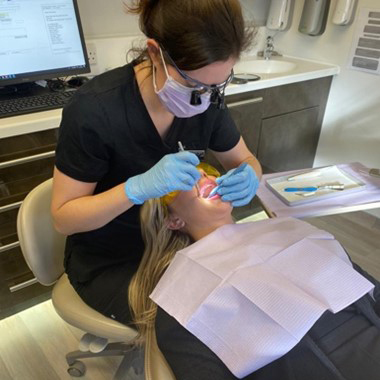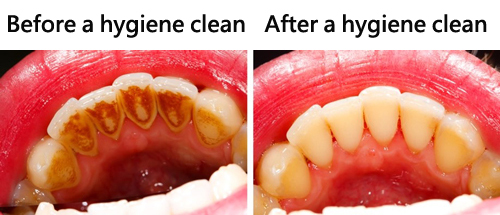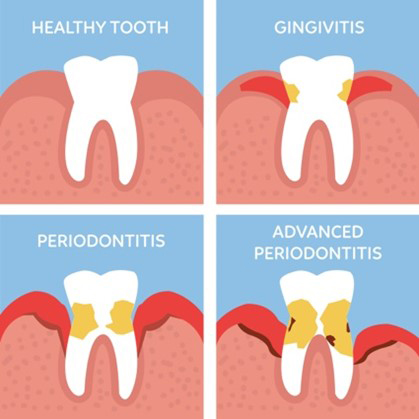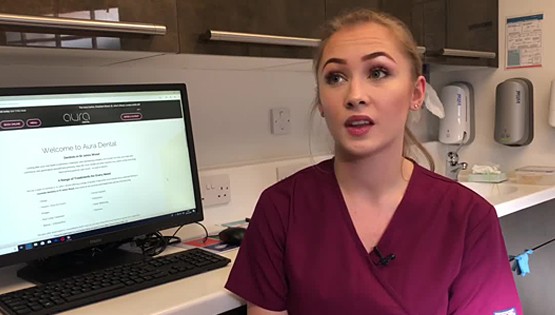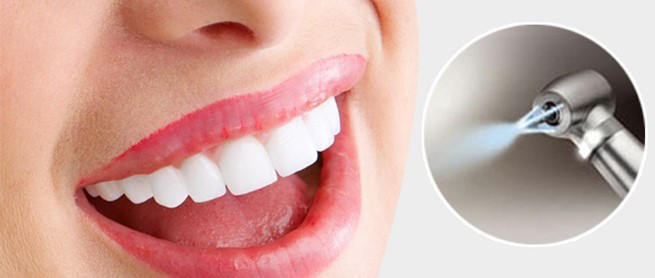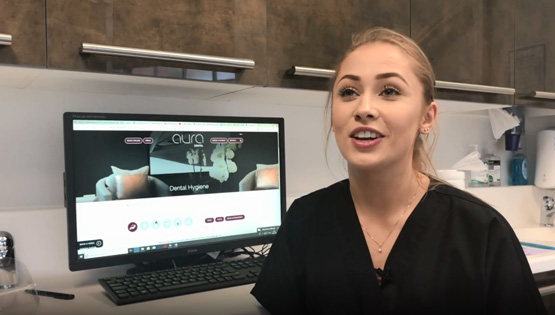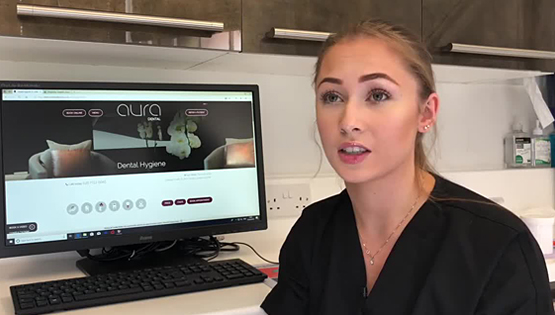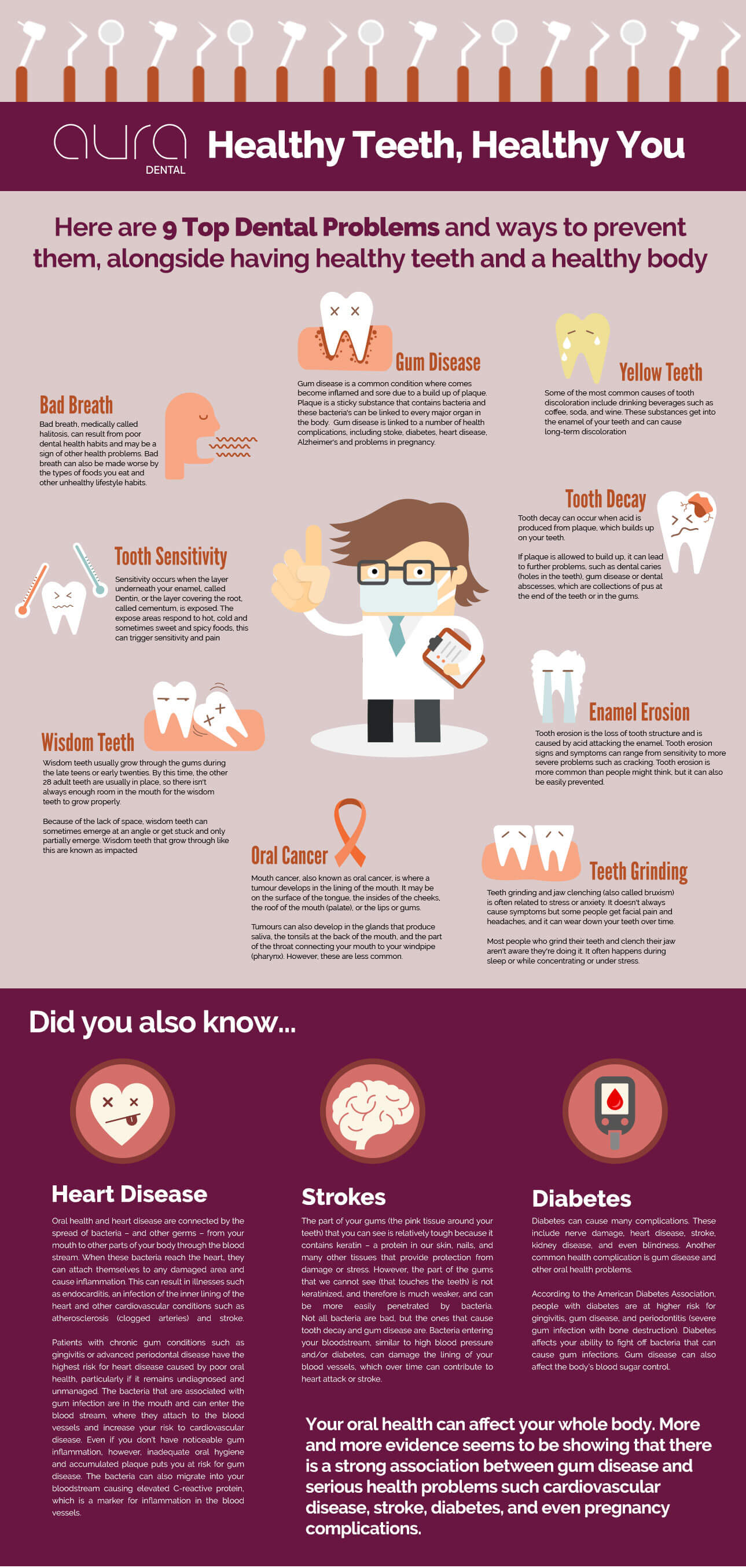The primary role of a hygienist is to assist people in the promotion, achievement and maintenance of good oral health. They are supervised by and work closely with a dentist. A dental hygienist trains for two years to achieve their professional qualification. Their role includes:
- Providing dietary and oral hygiene advice to all people and all ages, in the dental surgery and in various community environments (e.g. playgroups, youth groups and residential homes) in order to prevent dental caries (tooth decay) and periodontal (gum) disease.
- Giving smoking cessation advice and support.
- Treating periodontal disease by providing scaling and polishing ie cleaning above and below the gums to remove tartar (calculus) which has built up around the teeth, and polish off any surface stains.
- Giving injections to enable a pain-free experience when undertaking periodontal treatment.
A regular appointment with a dental hygienist may last for 30-45 minutes. A dental hygienist will initially check medical histories to ensure that any treatment they undertake will not cause health problems.
They may dye the plaque on the teeth to highlight any areas missed when using a toothbrush and floss and will offer appropriate oral hygiene advice to supplement a patient's daily oral hygiene regime. A hygienist will measure the gaps between gums and teeth with a rounded probe to explore whether any periodontal disease is present and will undertake any treatment necessary to prevent the disease from progressing. The gum condition will be monitored by the hygienist to ensure regular oral maintenance. They will also encourage regular 3-6 monthly scaling and polishing to ensure the routine maintenance of healthy gums.
Plaque is a sticky film of bacteria that collects on all the surfaces of teeth, particularly in between them and on the surfaces close to the gums. This dental plaque is the cause of tooth decay and gum disease.
When sugar and sugary products are eaten or drunk, the bacteria that live in the plaque produce acids that dissolve the minerals in the teeth and create holes (cavities). These acids begin to dissolve tooth enamel within 20 minutes of eating. The holes are usually painless – until they grow quite large inside the tooth. Without treatment, the decayed holes could eventually result in a tooth abscess.
If the gums are receding or there is gum disease present, tooth decay can develop on the exposed roots of the teeth. The roots of teeth are made from a softer material than the tooth enamel (dentine) and so holes will develop more quickly on the roots. Root surfaces also accumulate lots of plaque.
The type of food and how often it is eaten are more important than the amount of sugar involved. Sticky foods are more harmful than non-sticky foods because they remain on the surface of the teeth for longer. Frequent snacks increase the time that the harmful acids are in contact with the surface of the tooth.
Sugary snacks and drinks should be avoided, particularly between meals. If snacks are taken, they should be foods such as fruit, toast and cheese rather than sweets, biscuits and cakes. If sweets, biscuits and chocolates are eaten, it should only be once a day and then the teeth should be brushed afterwards.
Plaque is also a contributing factor to gum disease. When it collects around the necks of teeth it causes an inflammatory reaction in the gum. The gum then swells and creates a gap (pocket) between the tooth and gum. This pocket is more difficult to clean effectively, so more plaque builds up in the area and the pocket becomes deeper. This is a continuing cycle that can lead to serious long-term problems.
These problems caused by plaque can be controlled by keeping the teeth and gums clean. This is best done by regularly brushing (twice a day for two minutes) using a toothpaste containing fluoride and flossing (once a day).
Dental plaque is quite difficult to see, but there are special tablets (disclosing tablets) available from our reception. If chewed, they will colour the plaque to make it more visible. The use of mouthwashes containing fluoride will provide extra protection against tooth and root decay.
Scaling is the removal of calculus, plaque, tooth deposits and some stains. It can be done either above the gum (supra-gingival) or below the gum (sub-gingival).
If plaque and calculus is found above the gum scaling may be necessary. In more severe forms where plaque and calculus is found under the gum, scaling below the gum margin and root planing may be required. Either a dentist or a hygienist can carry out the scaling and root planing.
Scaling and root planing are done using special scaling instruments or ultrasonic devices. Hand instruments are made in various designs appropriate for reaching and removing plaque and calculus from all areas of teeth. The use of hand instrument can be tedious and time consuming.
Ultrasonic devices fracture deposits off the tooth surface. They also use water to help clear blood, debris, necrotic tissue and calculus. They are quicker to use and less tiring for the operator. However, some patients find them uncomfortable.
Depending on the amount of pre-existing plaque and calculus, scaling above the gum can take 30-45 minutes. Longer visits are necessary if it is a first visit and the patient has a lot of plaque and calculus. However, once the initial therapy has been done, and so long as good oral hygiene practices are carried out at home, subsequent maintenance visits can be as little as 30 minutes.
Sub-gingival scaling and root planing visits usually last an hour. The procedure normally requires a local anaesthetic.
Above the gum scaling is usually pain-free. However, if the gums are very inflamed, they can be very sensitive. If so, a topical anaesthetic cream or some local anaesthetic will be used to alleviate the pain. Below the gum scaling and root planing are usually done under local anaesthetic, so discomfort is infrequent.
In the treatment of periodontal disease, the advantages of scaling and root planing outweigh the disadvantages. This is because if periodontal disease is left untreated, it will lead to tooth loss.
Bad breath (halitosis) is a common reason why many people visit a dentist. Everyone suffers from bad breath to some degree at some time – for example, when waking in the morning, especially when we have eaten strong foods or drunk alcohol the night before. In the great majority of cases, the causes of bad breath originate in the mouth; in a minority of cases the problem may originate elsewhere in the body such as the stomach or nasal passages. It is important to know whether this is a cause of concern. This is where a dentist can help.
The main causes of bad breath are:
- Gum disease (periodontitis or gingivitis)
- Broken fillings or tooth decay trapping food between the teeth
- Secretions from the nose coating the back of the tongue.
It can be worsened by:
- Food (e.g. garlic, onion or curry)
- Alcoholic drinks
- Smoking
- Certain drugs (e.g. some heart medications, and drugs which decrease saliva production)
- Menstruation
- Illnesses (e.g. diabetes, kidney disease, liver disease, nasal infections, and sinusitis)
- Stress
- Gum disease
Gum disease is the most common cause of bad breath. It has two forms, gingivitis (inflammation of the gums) and periodontitis (infection of the gums). Periodontitis is the more severe condition. It affects the structures that hold the tooth in its socket and so can result in tooth loss. It often occurs with little or no pain and we are only aware of it when it is at a late stage. Bad breath can help us to detect this disease early.
Everyone has bacteria living in their mouth. When there is an inflammation or infection in the mouth, these bacteria digest human cells and produce by-products called volatile sulphur compounds, which smell like bad eggs. These compounds are produced in everyone's mouth during the night. People with gum disease produce more.
To avoid bad breath, regular six-monthly visits to a dental practice are essential.
The better the oral hygiene, the less the tartar builds up.
Tongue cleaning removes the surface coating on the tongue. It helps to reduce the number of sulphur-producing bacteria and dead cells which tend to stick to the tongue. This will also remove any fluids that have dripped from the nose back on to the tongue (post-nasal drip). A tongue can be cleaned daily either by using a specially made tongue scraper or by brushing it with a normal toothbrush (without using toothpaste).
Mouth rinses have been shown to be very effective at reducing bad breath. They remove the sulphur compounds from the mouth, thereby preventing them developing the 'bad eggs' smell. The use of antibacterial mouthwashes, gels or toothpaste, if used with good oral hygiene techniques, will reduce the number of bacteria in the mouth. They are best used at night in order to reduce morning bad breath. There is a wide variety available and a dentist will advise on the most suitable.
Avoid food or drinks which produce strong smells, such as garlic and onions, especially uncooked. Chew sugar-free chewing gum. Eat regular meals. Rinse your mouth with water or sip water during the day, especially if you have a dry mouth.
Tooth brushing is carried out to remove the sticky bacteria that form a harmful film on the teeth (dental plaque). These bacteria cause gum disease which is the most common disease in the world. The bacteria also act on sticky sweet foods forming acid that causes tooth decay.
When buying a toothbrush choose a small-headed medium strength brush that has a comfortable handle to grip. It needs to be replaced about every three months.
There are many types of electric tooth brushes available, some have timers, others are battery operated, and some are mains operated. Small-headed ones are better for small mouths. They are very efficient at cleaning if used correctly and are good for people who have a problem with dexterity. Electric brushes should be used following the manufacturer’s instructions.
Place the toothbrush head where the tooth meets the gum so that the bristles are just in the cuff of gum around the tooth. Start at one side of the mouth and carefully brush round to the next side using small gentle back and forth strokes. Do not scrub hard, as this will damage the teeth and gums. Use this technique on the outer surfaces near the cheeks and on the inner, surfaces near the tongue and around the palate. Finish by brushing the chewing surfaces. Brushing while looking in the mirror will help to check that none of the teeth are missed. Brushing correctly should take about two minutes.
An alternative method is to first move the lower jaw until the teeth are in edge-to-edge contact and brush all the outside surfaces of the teeth and gums gently and thoroughly with a circular motion. Next open the mouth and do the same to the inside surfaces of the top teeth and the surfaces of the lower teeth next to the tongue. Finally brush all the biting surfaces and rinse the mouth out to clear away the debris.
There are many different brands of toothpaste in the shops and nearly all of them contain fluoride. Fluoride is very important because it strengthens the teeth against decay. There are also toothpastes that help with sensitive teeth when eating something hot or cold and others that work against the harmful bacteria. Only a pea sized amount of paste is necessary as too much may cause a lot of foaming.
Although brushing removes most of the dental plaque there is usually some left between the teeth where the brush does not reach. It is very important to use another product to remove all the plaque. There are specially-designed brushes for cleaning between the teeth that look like small bottle brushes. They come in different widths so that they fill the spaces between your teeth.
They should be pushed gently back and forth between the teeth next to the gum. They should never be forced through, as this will damage the teeth. There are also brushes that have a single tuft and these are useful to clean around crowded teeth and orthodontic appliances (braces).
Dental floss is a special thread that is used for cleaning in between the teeth. The floss comes in different widths and most people find the thicker floss (tape) easier to use. Take about 50cm of floss and wrap it around the second finger of each hand leaving a small piece to work with. Using your thumb and index finger, pass the floss between the teeth and hold it in a ‘c’ shape round the tooth. Gently move it up and down, wiping off the plaque. Repeat this between each tooth using a fresh piece of floss by winding it on around your fingers. As with brushing, it is very helpful to watch your technique in a mirror to ensure you do not cause any damage to the gums. Flossing is a difficult technique and with all mouth care it is a good idea to ask for guidance from a dentist or dental hygienist. It is important to visit the dentist regularly to check that the mouth is healthy and so that any problems can be dealt with before they become serious.
Cleaning between the teeth is an important part of ensuring good oral hygiene. Careful brushing alone is not sufficient in preventing gum (periodontal) disease as the toothbrush bristles cannot penetrate all parts or sides of the teeth. Flossing should be done as it is effective in removing plaque from the areas where the toothbrush cannot reach and is also useful for removing food caught between the teeth. Flossing is particularly important where teeth overlap each other, where there is bridgework or if you are prone to gum disease.
Using dental floss requires time and an average level of manual dexterity, and needs to be undertaken daily. It is best to receive individual instruction from a dental professional as flossing with a poor technique may result in more problems than it solves. The dental professional can also ensure that your flossing is effective and can give advice about difficult areas in the mouth.
Initially, it is wise to use waxed dental tape, as it is slightly thicker, glides between the teeth easily, and does not fray around rough edges of fillings. Ensure that a mirror is used to see what is happening. Only floss a few teeth for the first few days, gradually building up to incorporate the whole mouth over a couple of weeks.
A methodical approach must be used to ensure all areas are effectively cleaned.
Use a piece of floss about 50cm long – there should be enough floss to ensure a firm grip on it with the fingers. It is recommended that a clean piece be used for each tooth. Wind the floss around the middle fingers so that the first (index) finger is free to guide the floss. Hold the floss tightly between the thumbs and index fingers so that about an inch (no more) is free. Gradually ease the floss between the teeth moving the floss from the biting surface into the space between the teeth, using a slight backwards-and-forwards motion. When the floss is in the space between the teeth, move it carefully into the gum groove (margin) which is slightly detached from the tooth surface. This is the natural cuff of gum that surrounds the tooth (the gingival margin). Curve the floss around one tooth surface, in a C shape, and gently slide the floss back towards the biting surface and out of the contact between the teeth.
One surface of one tooth has now been cleaned. Take a clean piece of floss, go back into the same space and clean the other surface with the same action. This now needs to be repeated with every tooth surface. It will take time and practice to become good at flossing. Persevere, as this is an effective method of cleaning between the teeth and should prevent gum (periodontal) disease.
There are various flossing aids available which may assist the process. A floss holder is a V-shaped piece of plastic into which the floss is wound. This acts as a substitute for your fingers so that the handle can be held and the floss slid into place. There are also floss picks which come packaged with floss attached to the floss holder.
For cleaning underneath bridges and around implants there is 'superfloss', which has a teased-out (fuzzy) section of floss and a built-in threader. When flossing around bridges, it is sometimes not possible to move the floss from the biting surface into the space between the teeth as the bridge metalwork is fused together, so the floss needs to be threaded underneath the bridgework. Using a similar action to flossing, ensure that the join between the tooth bridgework and gum is cleaned, as this is a particular area of plaque accumulation. The fuzzy part of superfloss is particular good for cleaning around implants.













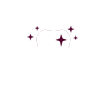


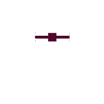





 My hygienist, Shashi, is so passionate about her work and makes a daunting appointment actually a breeze and I leave feeling like I have glistening teeth and a new smile!
My hygienist, Shashi, is so passionate about her work and makes a daunting appointment actually a breeze and I leave feeling like I have glistening teeth and a new smile! 

